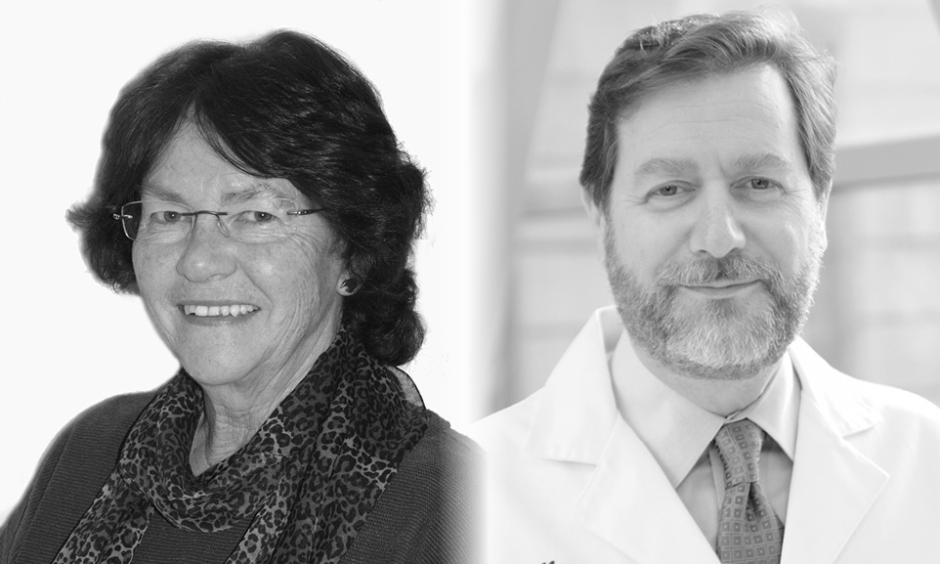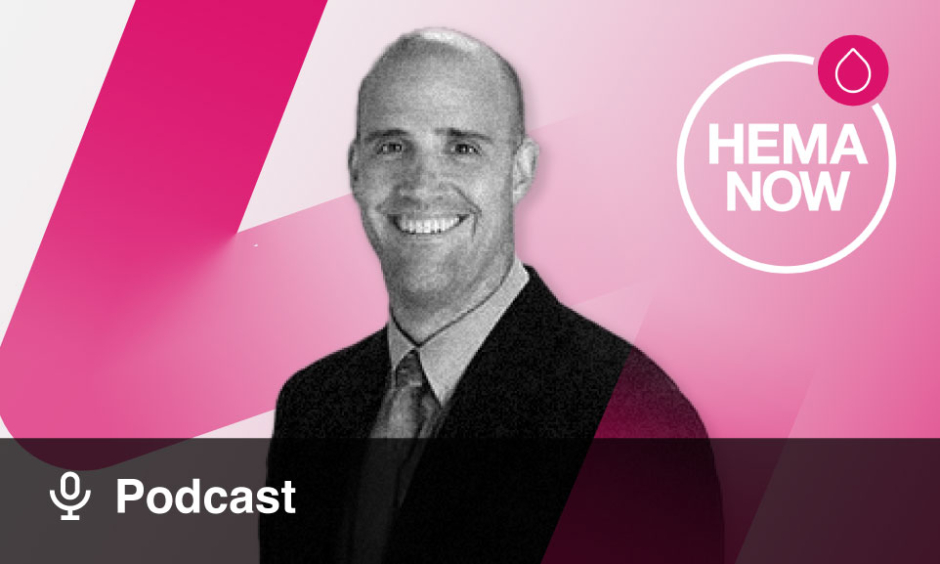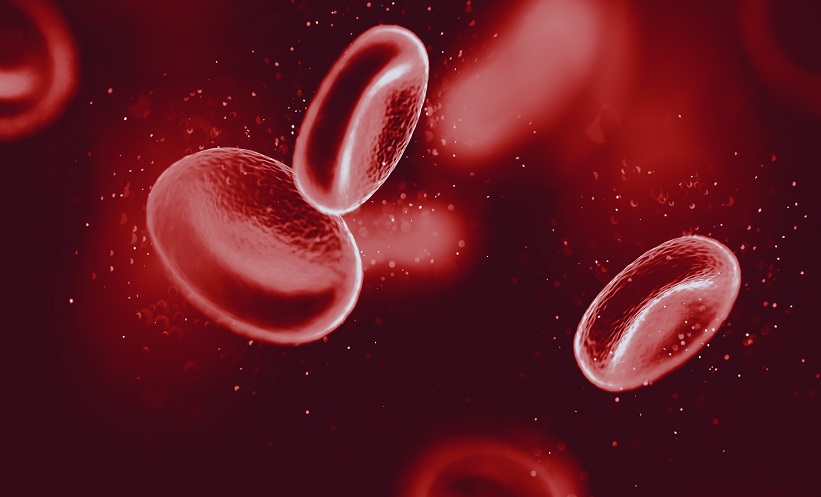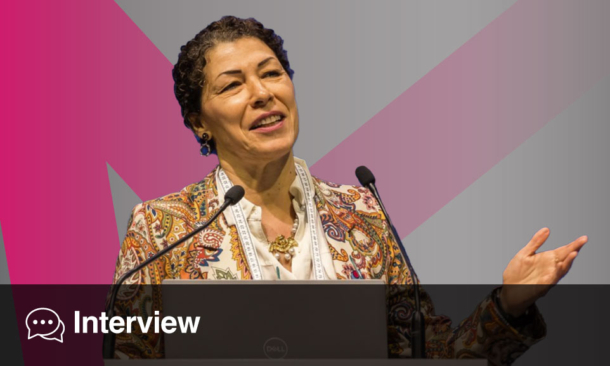We spoke to Prof Theresa L. Coetzer, the Chair of the ASH International Members Committee, and Dr Pierluigi Porcu, the Chair of ASH Foundation Committee to find out about their current research and how ASH is supporting the ever-growing field of haematology.
Prof Theresa L. Coetzer | Chair of the International Members Committee at the American Society of Hematology (ASH), Research Professor at the University of the Witwatersrand, Johannesburg, South Africa
![]()
You have a Bachelor of Science and Doctor of Philosophy in biochemistry. At what point did you know this was a particular passion of yours?
At school I was very interested in biology and science, and at university I realised that the field of biochemistry holds immense promise and will be at the forefront of exciting new discoveries.
A specific interest of yours is malaria and inherited haemolytic anaemias. What is it about this field of research that fascinates you?
I think the red blood cell is the most amazing cell in the body. When I started my PhD there was very little known about the role of the red cell membrane in the pathogenesis of inherited haemolytic anaemias, so there was lots of scope for new discoveries. The field developed rapidly, and novel molecular biology tools enabled cloning of the genes encoding the membrane proteins. By studying patients, it became possible to identify pathogenic mutations.
I have always been interested in malaria, especially since I live in a malaria endemic country and the main burden of malaria is in sub-Saharan Africa. Evolutionary pressure from the infection has modified the human genome and resulted in numerous inherited disorders of red blood cells, which provides a natural link between the two fields. The malaria parasite infects the red blood cell and interacts with the membrane, so it became a logical extension of my research. My fascination with this incredibly successful pathogen has increased over the years, and I expanded my studies to investigate the biology of the parasite with an overall aim of identifying new drug targets using cutting edge ‘omics’ technologies, including gene editing. I am currently involved in a South African malaria drug discovery consortium focussing on identifying compounds that block transmission of the parasite to the mosquito vector, which will assist global efforts in eliminating this deadly disease.
This has been the 61st ASH Annual Meeting. Why do you believe this has become such a successful event that is eagerly anticipated year on year?
The ASH Annual Meeting showcases the latest discoveries in haematology and represents the premier haematology meeting in the world since it only accepts high-quality abstracts that reflect novel unpublished data advancing the field. In addition, the education programme provides a superb update on the latest aspects of the chosen topics, and special sessions are held for trainee haematologists. The meeting has global impact and attracts the top echelon of scientists and clinicians that inspire all attendees, including young emerging researchers and trainees.
Which session do you consider to have been the most pivotal this year at the ASH Annual Meeting?
There were numerous excellent sessions at ASH this year that highlighted important discoveries and it is difficult to single out one particular session. However, the Presidential Symposium on big data and precision medicine, as well as the ASH-EHA Joint Symposium on haemato-metabolism provided important indications of where the field is going and how different disciplines are being integrated into haematological research endeavours.
One role of the International Members Committee is to maintain ASH communication with Health Volunteers Overseas (HVO). Could you tell us about why this is such a crucial relationship?
HVO is an organisation with a longstanding record of excellence in sending volunteers to low and middle-income countries to train local personnel. It is important for ASH to partner with HVO since HVO manages the logistics and administrative aspects of the volunteer assignments. The International Members Committee has representation on the HVO-ASH steering committee and can thus provide input and guidance on the haematology programme.
As the Chair of the International Members Committee, how do you perceive haematology treatment to differ across the globe?
Diagnosis and treatment of patients with haematological disorders differ markedly across the world and reflect the inequality of society. The high cost of new therapies precludes their use in resource-constrained countries, which unfortunately means that patients in these countries do not benefit from research advances and die because they cannot afford treatment.
A main focus of the International Members Committee is the educational programmes you are involved in. Are there any exciting programmes or opportunities ongoing currently?
The International Members Committee oversees several unique programmes that focus on training and education. For low and middle-income countries the well-established Visitor Training Program (VTP) and the related Latin American Training Program (LATP) build haematology capacity by providing funding for haematology-related healthcare professionals to receive up to 12 weeks of training on a specific topic or technique, anywhere in the world (VTP) or at specific centres in Latin America (LATP). Training occurs under guidance of an ASH mentor and awardees implement their new knowledge upon return to their home country. The HVO-ASH programme complements this by sending volunteer haematologists to train local individuals on-site in specific locations in low and middle-income countries. These programmes endeavour to mitigate the lack of expensive diagnostics and therapies by teaching local doctors to make the best use of available drugs and basic diagnostic techniques.
The International Outreach Initiative provides hospitals and universities in resource-constrained countries with free online access to educational materials, which help to address their haematological needs.
In addition, ASH has recently launched very exciting new international initiatives to expand their global portfolio. These include the Global Capacity-building Showcase, which highlights collaborative efforts to educate and train individuals in low-to-middle income countries, and the Global Research Award, which supports future leaders from countries at all levels of development.
Being the chair of such an important committee is obviously a great deal of workload to add onto one’s schedule. Why do you think it is important to be a part of such a committee?
I think it is important to be part of the International Members Committee to ensure that aspects of haematology of global interest and relevance are addressed. It has been a great privilege to lead this committee and all the hard work has been very rewarding. The international footprint of ASH has expanded rapidly over the past few years, and numerous exciting new initiatives have been launched that will ultimately benefit research and patient care globally, which emphasises the mission of ASH in “helping haematologists conquer blood diseases worldwide.”
What is the future of haematology as a specialty, and what are the largest problems that we will have to overcome?
I think haematology has a bright future since there is a wide spectrum and high burden of encompassing haematological diseases, and new therapies are emerging every year. Especially because of the readily accessible nature of blood and bone marrow samples, this is an exciting research discipline that facilitates major discoveries.
Dr Pierluigi Porcu | Chair of the ASH Foundation Committee, Sidney Kimmel Cancer Center, Philadelphia, Pennsylvania, USA
![]()
Can you please briefly explain how you came to become involved with the ASH Foundation Committee, and what its mission is?
I have been a member of ASH since I became a fellow in 1996, and it has been instrumental in supporting my career development as a haematologic malignancies researcher. ASH encourages all its members to engage in the activities of the society, become volunteers, and contribute to the overall mission, which is helping haematologists to conquer blood diseases worldwide. This can be done in multiple ways, one of which is to serve on committees and task forces. I became a member of the ASH Foundation Committee in 2014, and in 2016 I was appointed Committee Chair, a position I have held until this year. I am now stepping down as Chair and I will be serving ASH in other volunteer capacities.
The mission of the ASH Foundation Committee is publicly available on the ASH website, but briefly, the ASH Foundation Committee is responsible for collaborating with the Director of the ASH Foundation and ASH’s Executive Director to maximise charitable support from individual donors, foundations, and corporations. The Foundation’s mission is to move haematology forward through charitable support for ASH programmes and to help haematologists conquer blood diseases worldwide. As Committee Chair, I was gratified to see increases in the number of research and training awards, publications, and global programmes that would not have been possible without the funds raised by the ASH Foundation.
You presented at this year’s meeting a session on a combination therapy for Hodgkin lymphoma and T/NK cell lymphoma. Can you tell us a bit more about these findings?
This year I presented the Phase Ib data on an ongoing Phase Ib/II study of a new oral therapy for patients with Epstein–Barr virus (EBV)-positive relapsed/refractory lymphomas.1 The clinical trial combines orally administered nanatinostat (Nstat), a novel Class I histone deacetylase inhibitor (HDACi), with the known oral antiviral drug valganciclovir (VGCV). EBV-positive lymphomas are typically aggressive and have poor outcomes, with few exceptions. The rationale for this combination is that Nstat induces the expression of an EBV-encoded protein called BGLF4 that can activate VGCV, which then acts as a cytotoxic drug in EBV-infected cells. While the exact number of EBV-positive lymphomas in non-immunocompromised patients is not known because the presence of EBV is not routinely tested for in all lymphomas, we estimate that a significant fraction, possibly as high as 15–20%, of aggressive B-cell and T/NK-cell non-Hodgkin’s lymphomas (NHL) and 20–30% of Hodgkin’s lymphomas are EBV-associated.
Until now, with the exception of adoptive cell therapy strategies, no EBV-targeting therapy has been in clinical trials for this patient population. Our study evaluated the combination of Nstat and VGCV across three dose escalation cohorts. The combination was well-tolerated and the most common serious adverse events (AE) were haematologic; all were resolved without sequelae. No patients discontinued therapy due to a treatment-related AE. The most frequent treatment-related Grade 3–4 adverse events were thrombocytopenia (25%), neutropenia (20%), and anaemia (10%). All patients dosed at the recommended Phase II dose, including additional Phase IIa patients, had no Grade 3–4 haematologic AE. We observed responses across all doses, and in all lymphoma subtypes, including HDACi-refractory. We were able to determine the recommended Phase II dose of the combination, and the Phase IIa dose expansion portion of the study is now ongoing, with responses and no new severe adverse events. The overall response rate in the Phase Ib cohort was 56% (10/18), with 28% (5/18) complete response, and a clinical benefit rate (the sum of overall response rate plus stable disease rate) of 78% (14/18), with a median duration of treatment for responders of 6.5 months. Two responders remained on treatment for over 12.0 months, including one patient who remains in complete response at 17.0 months following 12.7 months on treatment. So, we are excited about the early results of this clinical trial, we are encouraged by what we are seeing in the Phase II part, and we are looking for a few additional participating institutions.
Given your extensive experience in lymphoma education and mentoring, is it a safe assumption to make that these are both vital aspects of your working career?
One of the most rewarding aspects of working in an academic environment, such as the Thomas Jefferson University, Philadelphia, Pennsylvania, USA, where the research and education missions are on par with patient care, is the interaction with students and trainees; the ability to work with bright, young fellows and junior faculty, and observe as they learn the basics, become confident, set their career goals, and then move on to establish themselves as independent investigators.
Mentoring is something that requires continuous and frequent interactions; the ability to give and take honest feedback, and a mutually agreed commitment to academic excellence and scientific rigor. You can talk these values, but you can only apply and teach them by example. The learning is often mutual, and I cannot think of a situation in which I did not learn something valuable myself from mentoring someone. The challenge these days is that the time that clinical faculty have to spend on mentoring and teaching is less and less, because in most institutions teaching is not valued as much as clinical effort, and mentoring is an activity that does not bring revenue and for which the return on investment is non-monetary and typically deferred. It takes visionary and strong leadership to support the academic mission, and that is not always available at all institutions.
You have spoken before of patient empowerment being an overarching principle of yours. What is your strategy for best achieving this empowerment? Are patients always equipped to process this information?
One of my strongest convictions, based on 20 years of empirical observations in the clinic, is that very few patients do not want to be active participants in their own care, particularly when they face an illness such as cancer, with its potentially devastating impact on themselves and their families. The guiding principle of my team at Jefferson is patient empowerment, based on knowledge. The more people know about their cancer, the more prepared they are for the journey, including how to face adversities and challenges along the way. Knowledge also grounds hope in facts; one of our foremost goals as oncologists must be to find ways to help patients and caregivers to discover how they can be part of the team and how they can be part of the solution. This is sometimes easier said than done, because every patient brings to the table a different set of experiences, educational backgrounds, personal beliefs, family or group traditions, emotions, and deep personal convictions that influence their perception of the reality they live in and the goals that they wish to achieve, sometimes irrespective of what is realistically doable. So, what is now often called cultural competency, and in the past was called bedside manners or human touch, is an absolutely indispensable core competency to be able to take care of patients with cancer.
In the Division of Hematologic Malignancies and Hematopoietic Stem Cell Transplantation at Jefferson, we have initiated a major research effort, in collaboration with our population science colleagues, to learn how to be effective communicators and how to productively interact with patients with blood cancer, in ways that are personalised and specific for the cancer type that each patient has. For example, we have an ongoing project in T-cell lymphoma, which is a rare type of lymphoma for which there is very little information.
You recently published a review on cutaneous T-cell lymphoma, specifically advances in disease diagnosis. Can you summarise some of the take-home messages of this paper?
Cutaneous T-cell lymphomas (CTCL) continue to represent a significant diagnostic challenge, particularly in early stage, although technological innovations, such as high throughput sequencing of the T-cell receptor (TCR), are now being introduced in the diagnostic work up that are very likely to lead to significant advances in care, including early diagnosis. Still, resolving a difficult diagnostic dilemma remains an everyday challenge for oncologists and dermatologists, which involves synthesising varied clinical presentations with complex immunohistochemical findings as well as molecular data and ancillary testing, such as flow cytometry and standard TCR gene rearrangement analysis. The field is also ever changing, with new diagnostic and prognostic considerations flooding the literature, making sorting through the latest developments seem almost impossible.
In 2017, the World Health Organization (WHO) published a major revision of the fourth edition of the classification of haematopoietic and lymphoid neoplasms and introduced several changes to the current classification and understanding of CTCL. Many of the subtypes described in the latest WHO classification are quite rare and may not be routinely encountered, thus a basic knowledge of the categories is the first step to diagnosis.
One of the key elements of a successful diagnosis of CTCL is a strong familiarity with all its clinical manifestations because a skin biopsy often cannot be adequately interpreted without knowing the clinical context in which it was obtained, which should include the visual inspection of the lesions. Another key element is not to rely too heavily, or exclusively, on molecular analyses such as TCR gene rearrangement analysis. Too often we see skin biopsy reports deferred and being held hostage to the TCR gene rearrangement analysis, often delayed because it is done at reference labs. Thirdly, be watchful for CTCL subtypes that may be difficult to distinguish from systemic, non-cutaneous T-cell neoplasms, such as ALK1-negative anaplastic large cell lymphoma (ALCL), mature T-cell leukaemias, and NK cell lymphomas. Finally, be aware of the exceptions that prove the rule. For example, the ruling dogma is that primary cutaneous ALCL is always ALK1 negative, which is almost always true. However, there are rare cases of ALK1-positive ALCL, particularly in young patients that are clearly skin limited, and therefore fall under the classification of primary cutaneous ALCL.
Finally, with the continued development of exciting immunotherapies, this is a very exciting time for the haematological field. What areas of research are you most anticipating heading into the new year?
The immune-oncology revolution is clearly one of the most inspiring scientific tales of the last decade. I believe that in the next year we will be learning much more about how to combine different immune-oncology drugs or different immunotherapy modalities, not limited to the canonical checkpoint inhibitors such as PD-1 and PD-L1/2. A number of drugs targeting other immune checkpoints, such as TIGIT, TIM-3, CD47, VISTA, KIR, just to name a few, are in clinical trials.
In addition, I am very excited about a number of new bispecific, and tri-specific, antibodies that combine a tumour cell engager moiety with an effector cell engager. And now a new class of sophisticated multi-specific antibodies that simultaneously bring activated effector cells in close proximity to the tumour cell, while inhibiting co-inhibitory signals, are in development. We will also be learning more on cellular therapy with T cells or NK cells that carry new chimeric receptors. Finally, we will start learning more about mechanisms of resistance to immuno-oncology drugs and how to overcome them with new strategies.
References
- Viracta Therapeutics, Inc. Dose escalation & expansion study of oral vrx-3996 & valganciclovir in subjects with ebv-associated lymphoid malignancies. NCT03397706. https://clinicaltrials.gov/ct2/show/NCT03397706.







